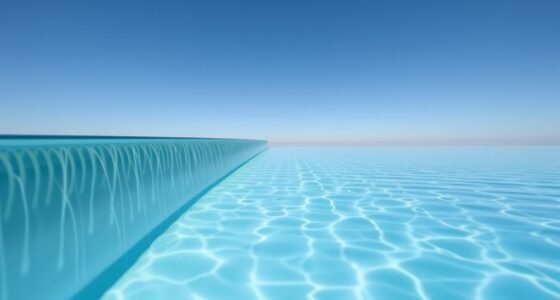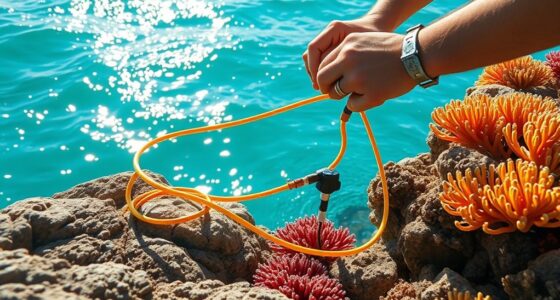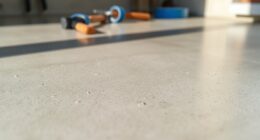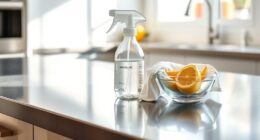To stop your make-up water from vanishing and save costs, focus on reducing evaporation by installing covers, floating barriers, or shade structures on open water surfaces. Maintain your systems regularly, detect leaks early with sensors, and fix issues promptly. Consider using chemical treatments to prevent corrosion and buildup that cause leaks. Designing your facilities thoughtfully and adopting water-efficient practices can make a big difference. Keep going to discover more proven strategies to protect your budget.
Key Takeaways
- Implement cover systems and shading to minimize water surface exposure and reduce evaporation rates.
- Regularly inspect and repair leaks to prevent unnecessary water loss and improve efficiency.
- Use sensors and monitoring tools to detect leaks early and optimize make-up water usage.
- Incorporate water-efficient designs and fixtures to lower overall water demand and waste.
- Develop a comprehensive water management plan with clear targets and staff training for sustainable conservation.
Understanding Evaporation and Its Impact on Water Usage
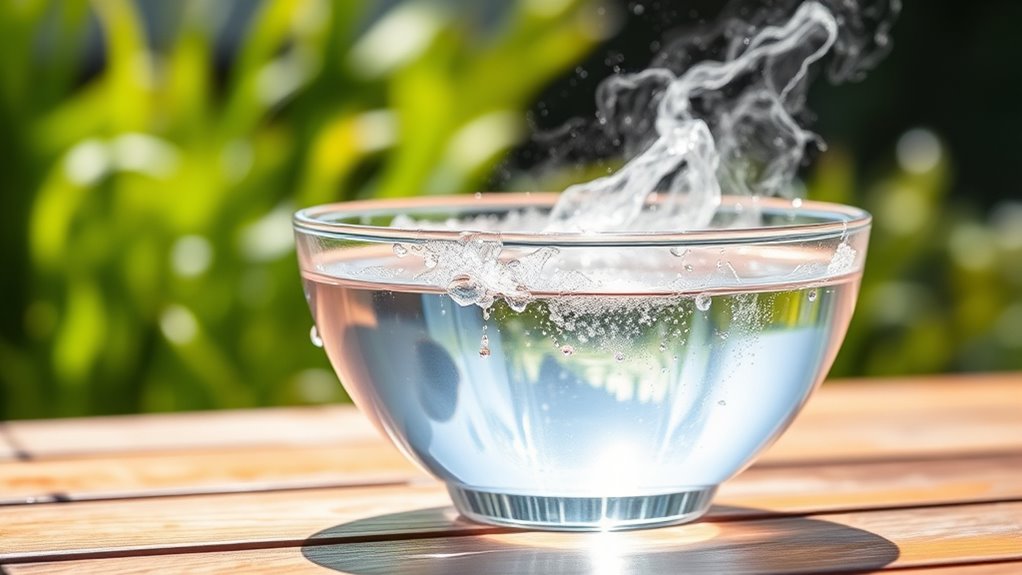
Evaporation is the process where water turns into vapor and escapes into the atmosphere, and it plays a significant role in water management. When water evaporates from your facilities, it reduces the amount available for use, increasing your demand for make-up water. Factors like temperature, humidity, and surface area influence evaporation rates, meaning hot, dry conditions accelerate water loss. Understanding this process helps you predict how much water your equipment or basins might lose daily. If you neglect evaporation, you could be unknowingly wasting resources and raising operational costs. Recognizing evaporation’s impact allows you to implement better water management strategies, such as covers or reduced surface exposure, to minimize loss. Effective control methods for evaporation can significantly reduce water wastage and operational expenses. Controlling evaporation is essential for optimizing water use and maintaining efficiency in your system.
Identifying Common Sources of Water Loss in Facilities

Understanding how water escapes from your facilities is essential for effective water management. Common sources of water loss include leaks in pipes, fittings, and valves, which often go unnoticed until significant damage or increased bills occur. Overflows or splashes from cooling towers, tanks, or process equipment can also contribute to unnecessary water use. Evaporative losses, especially in open systems, are unavoidable but can be minimized through proper maintenance. Additionally, inefficient control of water levels or inadequate monitoring can lead to overuse. By regularly inspecting equipment, fixing leaks promptly, and monitoring water consumption patterns, you can identify where water is being wasted. Recognizing these sources allows you to target areas for improvement, ultimately reducing water loss and cutting costs.
Assessing Your Current Make-Up Water Practices

To effectively manage your make-up water practices, you need to evaluate how you’re currently sourcing, using, and monitoring make-up water within your facility. Start by reviewing your water input records to identify patterns and inconsistencies. Check your instrumentation and control systems to guarantee accurate readings and proper operation. Assess how much water is added during different operational cycles and whether any excess is being used unnecessarily. Examine your procedures for detecting leaks or losses and how often maintenance occurs. Consider whether your staff is trained to follow best practices for water management. Additionally, understanding filtration systems can help you determine if your water quality contributes to waste or inefficiencies. By understanding these aspects, you can identify inefficiencies, prevent overuse, and establish a baseline for implementing improvements that reduce waste and save money.
Implementing Cover Systems to Reduce Evaporation

Choosing the right cover material is essential for effectively reducing evaporation, so consider durability and compatibility with your water system. Proper placement of the cover ensures maximum coverage without gaps or folds that can cause evaporation. By focusing on these points, you can implement cover systems that markedly cut water loss. Additionally, selecting materials suited for Water Parks can enhance longevity and performance in various environments.
Cover Material Selection
Selecting the appropriate cover material is essential for effectively reducing evaporation in water containment systems. You need to take into account factors like durability, reflectivity, and chemical resistance to guarantee the cover withstands environmental conditions. Reflective surfaces, such as white or aluminized materials, help minimize heat absorption, lowering evaporation rates. Flexibility and ease of installation are also critical, especially if you require frequent access or maintenance. Some materials, like high-density polyethylene (HDPE) or specialized vapor barriers, provide long-lasting performance and weather resistance. Additionally, make sure the material is compatible with your water quality and chemical treatments. Proper selection not only reduces water loss but also protects your system from contaminants, making it a smart investment for managing evaporation and conserving water effectively. Incorporating vertical storage solutions can further optimize your water management by maximizing space and reducing the need for frequent cover adjustments.
Effective Cover Placement
Proper placement of your cover system is key to maximizing evaporation reduction in water containment. Guarantee the cover fits tightly and extends evenly across the entire surface to prevent air leaks and water loss. Avoid gaps around the edges where evaporation can escape. Secure the cover firmly to withstand wind and weather conditions, maintaining its position over time. Check for wrinkles or folds that could trap air or cause leaks, and smooth them out. Regularly inspect the installation to identify any damage or displacement. Properly aligned covers also minimize debris accumulation, preserving their effectiveness. Keep in mind that color accuracy can influence the visual quality of your monitoring displays, ensuring you can detect issues promptly. Remember, a well-placed cover acts as a barrier, reducing evaporation and saving water. Invest time in correct placement to see the best return on your evaporation control efforts.
Enhancing Facility Design for Water Conservation

You can substantially cut water use by optimizing your cooling system layout to minimize evaporation. Incorporating water-efficient fixtures helps reduce overall consumption, while designing for reduced evaporation ensures your facility conserves water more effectively. These strategies work together to make your operations more sustainable and cost-efficient. Additionally, understanding the water consumption patterns of your facility can help identify further opportunities for water savings.
Optimize Cooling System Layout
Optimizing the layout of cooling systems plays a crucial role in enhancing water conservation efforts within a facility. A well-designed layout reduces water loss and improves efficiency, saving you money and resources. Start by positioning cooling towers to maximize airflow and minimize recirculation. Ensure pumps are located close to cooling units to reduce piping length and energy waste. Implement zoning to isolate sections needing less cooling, decreasing unnecessary water use. Use modular systems that can adapt to changing demands, preventing over-application. Regularly inspect and maintain components to prevent leaks and inefficiencies. Understanding the core traits of a well-structured system not only conserves water but also boosts system performance, making your facility more sustainable and cost-effective.
Incorporate Water-Efficient Fixtures
Incorporating water-efficient fixtures into your facility’s design is a straightforward way to substantially reduce water consumption. By choosing low-flow toilets, faucets, and urinals, you can cut water use without sacrificing performance. These fixtures deliver the same results while using less water, helping you save money and protect resources. Imagine the impact of small changes—less water wasted, lower bills, and a greener footprint. Using water conservation strategies can further enhance these efforts and maximize savings.
Design for Reduced Evaporation
Designing your facility to minimize evaporation is a critical step in water conservation. By implementing smart design choices, you can substantially reduce water loss and save costs. Consider covering open water surfaces with floating covers or shade structures to block sunlight. Use windbreaks like fences or plantings to reduce wind speed over water. Incorporate recirculation systems that minimize exposed water areas. Opt for closed-loop designs where possible to eliminate evaporation altogether. Additionally, positioning tanks and basins in shaded or sheltered locations can lower evaporation rates. Employing material choices that enhance insulation and reduce heat transfer can further decrease evaporation rates. These strategies not only conserve water but also improve operational efficiency and reduce your overall water footprint. Taking these design steps ensures a more sustainable, cost-effective facility that’s better equipped for water conservation.
Utilizing Sensors and Monitoring Technologies for Leak Detection

Utilizing sensors and monitoring technologies has become essential for early leak detection in evaporation and make-up water systems. These tools provide real-time data, allowing you to identify leaks before they escalate into cost-effective issues. Flow meters and pressure sensors can detect abnormal fluctuations, signaling potential leaks immediately. Ultrasonic sensors listen for irregular sounds indicating water escape, while level sensors monitor reservoir changes. Automated monitoring systems compile data and send alerts directly to your device, enabling swift action. By integrating these technologies, you reduce water loss, lower operational costs, and improve system efficiency. Early detection also minimizes damage and maintenance needs. Incorporating water conservation practices and sensor data analysis further enhances leak prevention efforts. Overall, leveraging sensors and monitoring systems empowers you to maintain optimal water levels, prevent waste, and protect your budget from unnecessary expenses.
Applying Chemical Treatments to Minimize Water Loss

Applying chemical treatments effectively reduces water loss by preventing issues like corrosion, scaling, and biological growth in evaporation and make-up water systems. These treatments help maintain peak system performance and extend equipment lifespan. To achieve this, you should regularly analyze water chemistry and adjust chemical dosages accordingly. Using proper inhibitors and biocides can stop corrosion and inhibit algae or bacteria growth. It’s also vital to monitor pH levels to ensure treatments work effectively. Consistent chemical management prevents unexpected system shutdowns and reduces water wastage.
Proper chemical treatment reduces water loss by controlling corrosion, scaling, and biological growth in water systems.
- Use corrosion inhibitors to protect metal components
- Apply scale preventatives to reduce mineral buildup
- Incorporate biocides to control biological contamination
- Regularly test water chemistry for peak dosing
- Maintain proper pH levels for treatment effectiveness
Developing a Water Management Plan for Sustainability

Building on the importance of chemical treatments to minimize water loss, creating a thorough water management plan guarantees that your system operates efficiently and sustainably over time. Start by evaluating your current water usage, identifying areas where evaporation or leaks occur. Set clear goals for reducing water consumption and establishing benchmarks for performance. Incorporate regular monitoring, so you can promptly detect issues and make adjustments. Implement best practices, such as optimizing fill levels, controlling evaporation through covers, and scheduling maintenance proactively. Educate staff on water-saving procedures to ensure everyone is aligned with sustainability goals. A well-designed plan not only minimizes water waste but also extends equipment lifespan and reduces operational costs, helping you maintain a balanced, eco-friendly system.
Cost-Saving Strategies and Long-Term Maintenance
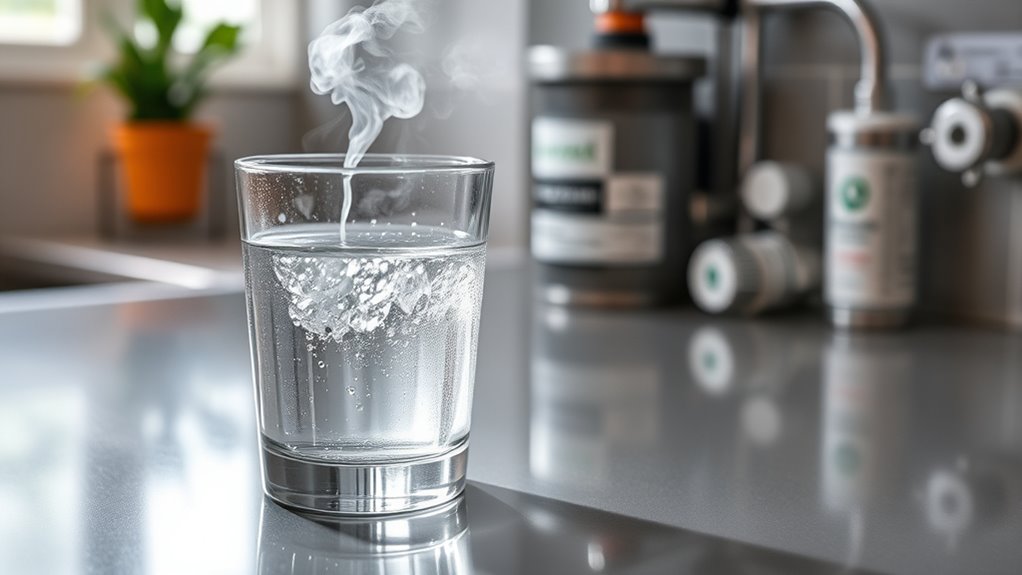
To maximize savings and guarantee your system remains reliable over time, focus on implementing effective cost-saving strategies and scheduling regular long-term maintenance. Regular inspections help identify leaks, corrosion, or wear early, preventing costly repairs later. Optimize water treatment processes to reduce chemical usage and energy consumption. Invest in upgrades like automatic controls or sensors to better monitor evaporation rates and make-up water needs. Training staff on best practices ensures efficient operations. Additionally, develop a routine maintenance schedule to clean, calibrate, and replace worn components promptly. These steps minimize water loss, extend equipment lifespan, and lower operational costs. Staying proactive with maintenance encourages consistent system performance and long-term budget stability, helping you avoid unnecessary expenses and ensure sustainable water management.
Frequently Asked Questions
How Do Weather Conditions Affect Evaporation Rates in Facilities?
Weather conditions directly impact evaporation rates in your facilities. Hot, dry, and windy days increase evaporation because heat and airflow speed up water loss. Conversely, cooler, humid, and calmer weather slow down evaporation. You should monitor daily weather patterns and adjust your water management practices accordingly. Implementing measures like covering open water surfaces or reducing exposure can help control evaporation, saving water and reducing costs.
What Are the Most Cost-Effective Cover System Options for Different Facilities?
You should consider cost-effective cover options like floating covers for ponds, which are easy to install and maintain, or fixed covers for tanks that provide long-term savings. For large open surfaces, lightweight geomembranes offer a budget-friendly solution. You might also explore modular covers that can be customized to your facility’s size and needs. Prioritize durability and ease of installation to maximize your investment and reduce evaporation effectively.
How Can Facility Staff Be Trained to Monitor Water Loss Effectively?
You should train staff through hands-on workshops and clear guidelines that emphasize routine checks of water levels and leak detection. Encourage them to document their observations and report anomalies promptly. Use visual aids and real-world examples to reinforce best practices. Regular refresher courses keep skills sharp, and fostering a team approach guarantees everyone stays vigilant, ultimately reducing water loss and saving costs efficiently.
Are There Environmentally Friendly Chemical Treatments to Reduce Evaporation?
Yes, there are environmentally friendly chemical treatments that help slow evaporation. You can use natural polymer-based coatings or plant-derived sealants that form a breathable barrier, like a gentle shield over water surfaces. These eco-conscious options act like a soft armor, reducing water loss without harming the environment. By choosing these treatments, you keep your water levels steady and your conscience clear, all while protecting your budget and the planet.
What Are the Latest Technological Innovations in Leak Detection Systems?
You can now leverage advanced leak detection systems that use smart sensors and real-time data analytics to quickly identify leaks. Innovations include acoustic sensors that detect sound anomalies, infrared thermography for pinpointing temperature changes, and machine learning algorithms that predict leak patterns. These technologies offer faster, more accurate detection, minimizing water loss and reducing costs. Implementing the latest systems helps you maintain efficient water management and protect environmental resources effectively.
Conclusion
By understanding evaporation and implementing smart water management strategies, you can drastically cut your make-up water costs. Some say covering surfaces prevents evaporation entirely—while not entirely true, it’s a proven way to save significant amounts. Think of it like wearing a raincoat in a storm—you won’t stop all water loss, but you’ll definitely stay drier. With the right tools and practices, you’ll keep your budget from vanishing, proving that small changes make a big difference.



